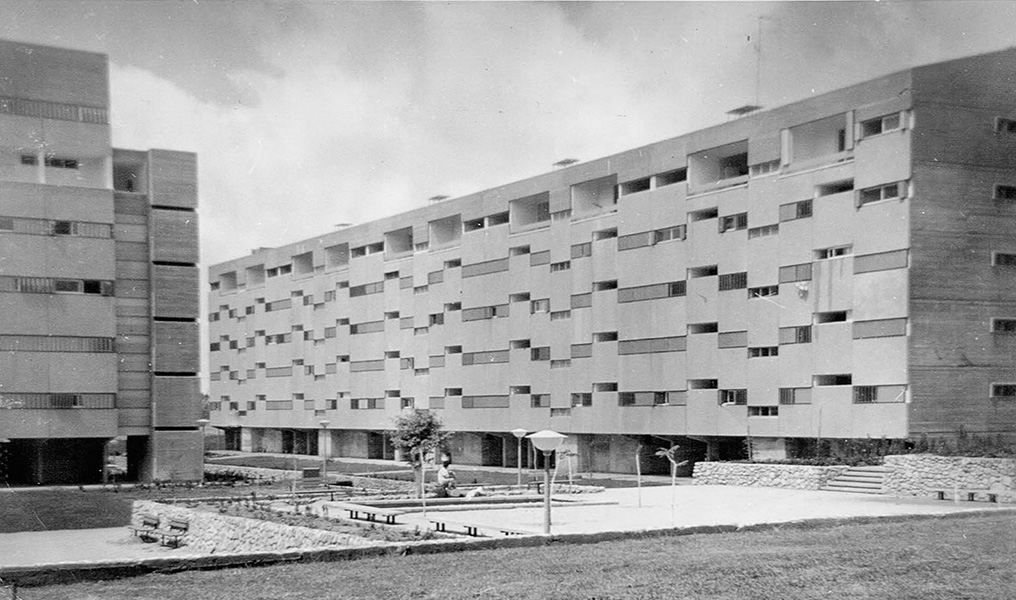Mass Housing Estates and the Consolidation of the Israeli Urban Middle-Class
Additional Files
DOI:
https://doi.org/10.52200/docomomo.68.02Keywords:
Architecture history, Housing, Middle-Class, Mass Housing, IsraelAbstract
Middle-class housing in the context of post-independence growth in Israel, where urban growth was guided by the massive construction of new neighborhoods and buildings, produced various types of shared dwellings which became the prevailing types of urban housing. While mass housing is discussed in the context of Israel as a key device of a modernization project on the national scale, with deep consequences for marginalized immigrants and the lower classes – it has rarely been studied as housing typology for the middle classes. Nonetheless, urban growth and national consolidation starting the 1960s led to an emerging urban middle class, whose housing was the product of diverse actors, including urban and national policy, private contractors, neighborhood associations, financial systems, architects, and planners. Yet, as the social category ‘middle class’ is muddled, how can we distinguish mass housing for the middle classes, or middle class housing?
This paper examines the architectural features of three middle-class mass housing estates built in Israel in the 1960s. Asking what constitutes the middle class, we point to the capacity of an architectural analysis to identify the designed elements that construct a middle-class identity within the context of shared urban dwellings. The three cases briefly examined include the Be’eri estate in Tel Aviv, Kiron estate in Kiryat Ono, and Shchuna Bet in Beer Sheba. The three estates, developed in the 1960s by commercial and semi-commercial companies explicitly for the emerging urban middle class, employ New Brutalist architectural and urban design principles in mitigating community and individuals, public and private, identity and property.
How to Cite
Published
Issue
Section
License
Copyright (c) 2023 Yael Allweil, Inabl Ben-Asher Gitler

This work is licensed under a Creative Commons Attribution 4.0 International License.
Plaudit
References
ALLWEIL, Y. (2017). Homeland: Zionism as Housing Regime, 1860-2011. Oxon: Routledge. DOI: https://doi.org/10.4324/9781315395982
ALLWEIL, Y., & ZEMER, N. (2022). Brutalism and community in middle class mass housing: Be’eri Estate, Tel Aviv, 1965–present. Urban Planning, 7(1), 349-368. DOI: https://doi.org/10.17645/up.v7i1.4811
BEN-ASHER GITLER, I and GEVA, A. (2018). Brutalism ve-Structuralism Banegev: Trumato shel Eldar Sharon [Brutalism and Structuralism in the South: The Impact of Eldar Sharon] in: Eran Neuman )Ed.), Arieh Sharon: Adrichal Hamedina [Arieh Sharon: The State’s Architect], Tel Aviv: Tel Aviv Museum of Art (in Hebrew).
BINYANEI BE’ERI [Be’eri housing]. (1963, 6, 28). [Advertisement]. Davar newspaper collection, Israel National Library Newspaper Collection (in Hebrew).
CARAMELLINO, G. (2015). The Middle-Class Project. Designing New Ways of Living in the Post-War City.
CARAMELLINO, G., & DE PIERI, F. (2015). Domestic Italy after WWII: Collecting stories from middle-class houses. CANDIDE, 6, 45–72.
GLIKSON, A. (1973). Dyun al nosee hamegurim [discussion of the housing topic], Architecture in Israel, Society of architects and engineers in Israel, Tel Aviv (in Hebrew)
KARMI, D. (1946). Mibaayot tichun hadirot beTel Aviv [Problems in planning apartments in Tel Aviv]. Journal of the Federation of Engineers and Architects in Israel, 1946(7), 3–4 (in Hebrew).
KARMON, N., & CHEMANSKI, D. (1990). Housing in Israel, from planned economy to semi-free market management. Technion Center for Urban and Regional Studies.
KIRON BROCHURE, (1964). Israel Lotan archive at Israel National Library (in Hebrew).
KIRONEWS, (1966). Issue 7, January 1966. Israel Lotan archive at Israel National Library (in Hebrew).
SHARON, A. (1970). Binyanei yachid oh architectura colelet [Individual buildings or comprehensive architecture]. [Speech transcript]. Arieh Sharon lecture files. The Azrieli Architectural Archive, Tel Aviv Museum of Art, Tel Aviv, Israel (In Hebrew).
SIKUMEY PE’ULOT MISRAD HASHIKUN, MECHOZ HANEGEV 1963-1968 [Building and Construction in the Negev: Activities of the Ministry of Housing Negev Region, 1963-1968]. Beer Sheba: Ministry of Housing, 1969 (In Hebrew).
SHABTAI-CYZER, N. (2011). The Kiron Housing Complex, Kiryat Ono: Contemporary Conservation Challenges, MA Thesis, Technion Faculty of Architecture.
SHIKUN OVDIM (1971).[Advertisement], Ma’ariv: Yamim VeLeylot, 4 June 1971, 20-21 (in Hebrew). DOI: https://doi.org/10.7901/2169-3358-1971-2-21
SLEIFFER, J. (1999). Hahityashvut HaIronit 1948-1968 – Hirhurim shel Mishtatef Pa’il [Urban Settlement 1948-1968 – Thoughts of an Active Participant] in Tovia, M. and Boneh, M. Binyan Ha’Aretz, Shikunim beShnot Hachamishim [Building the Land: Housing in the 1950s]. Tel Aviv: Hakibbutz Hameuchad (in Hebrew).
STEINER, H. (2011). Life at the Threshold. October, 136, 133-155. DOI: https://doi.org/10.1162/OCTO_a_00045
TOVIA, M. and Boneh, M. (1999). Shikunim beShnot Hachamishim [Housing in the 1950s] in Tovia, M. and Boneh, M. Binyan Ha’Aretz, Shikunim beShnot Hachamishim [Building the Land: Housing in the 1950s]. Tel Aviv: Hakibbutz Hameuchad (in Hebrew).
VAN DEN HEUVEL, D. (2015). Between brutalists. the Banham hypothesis and the Smithson way of life. The Journal of Architecture, 20(2), 293-308. DOI: https://doi.org/10.1080/13602365.2015.1027721
YAVIN, S. (1980). Hanchayot programatiot letichnun kvuzat hamegurim [programmatic instructions for design of the housing group], Society of architects and engineers in Israel, Tel Aviv (in Hebrew).





